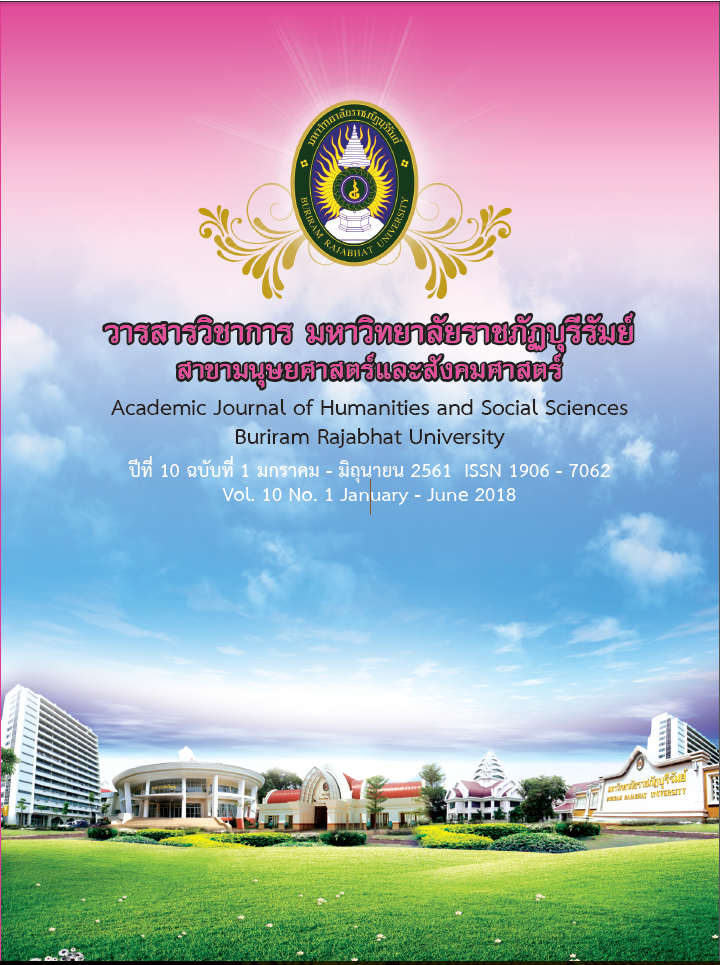มิติสัมพันธ์: ความบกพร่องที่ไม่ควรมองข้าม
Main Article Content
บทคัดย่อ
ความสามารถด้านมิติสัมพันธ์เป็นความสามารถในการรับรู้ภาพในเรื่องของการมองโดยใช้จินตนาการ
จากประสาทสัมผัสที่สัมพันธ์กับสิ่งต่าง ๆ รอบตัว ทำาให้เกิดความคิดรวบยอดในการแยกแยะ สี รูปร่าง
รูปทรงสัณฐาน ลักษณะพื้นผิว มิติความลึก มิติความกว้าง ยาว หนา สูง และเป็นหนึ่งในความสามารถ
ด้านพหุปัญญา (Carroll, 1993; Gardner, 2011; McGee, 1979) การศึกษาที่ผ่านมาแสดงให้เห็นว่า
มิติสัมพันธ์ มีความสำาคัญต่อการพัฒนาในด้านต่าง ๆ เช่น การมองเห็นมโนภาพในจิตใจเชื่อมโยงต่อ
พื้นฐานทางพัฒนาการด้านอื่น ๆ ในชีวิตประจำาวัน (Katsioloudis & Jovanovic, 2014) ที่ผ่านมา
มีการนำาเสนอวิธีพัฒนาความสามารถด้านมิติสัมพันธ์หลากหลายวิธีด้วยกัน ผู้เขียนได้ทบทวนแนวคิด
ทฤษฎี บทความ และงานวิจัยที่เกี่ยวข้องกับ ความหมาย ความสำาคัญ สาเหตุ และวิธีการพัฒนาความ
สามารถด้านมิติสัมพันธ์ แสดงให้เห็นว่าเป็นเรื่องสำาคัญที่ผู้เกี่ยวข้องควรให้ความสนใจ ซึ่งความบกพร่อง
ด้านนี้เป็นสิ่งจำาเป็นที่ควรได้รับการพัฒนา เพื่อที่ผู้ที่มีความบกพร่องด้านมิติสัมพันธ์จะสามารถกระทำา
และเรียนรู้สิ่งรอบตัวได้เต็มศักยภาพเหมาะสมกับช่วงวัย
Article Details
- ต้นฉบับที่ได้รับการตีพิมพ์ในวารสารวิชาการ มหาวิทยาลัยราชภัฏบุรีรัมย์ สาขามนุษยศาสตร์และสังคมศาสตร์ ถือเป็นกรรมสิทธิ์ของมหาวิทยาลัยราชภัฏบุรีรัมย์ ห้ามนำข้อความทั้งหมดหรือบางส่วนไปพิมพ์ซ้ำเว้นเสียแต่ว่าจะได้รับอนุญาตจากมหาวิทยาลัยฯ เป็นลายลักษณ์อักษร
- เนื้อหาต้นฉบับที่ปรากฏในวารสารเป็นความรับผิดชอบของผู้เขียน ทั้งนี้ไม่รวมความผิดพลาด อันเกิดจากเทคนิคการพิมพ์
เอกสารอ้างอิง
ที่มีความบกพร่องด้านการอ่าน. วารสารสงขลานครินทร์, 34, 211-221.
มุกดา หนุ่ยศรี. (2016). การป้องกันภาวะสมองเสื่อม. วารสารพยาบาลตำารวจ, 8(1), 227-240.
สุภาพร ศรีหามี. (2014). ผลการใช้โปรแกรมฝึกการวาดรูปทรงเรขาคณิตสำาหรับเพิ่มความสามารถ
ด้านมิติสัมพันธ์ของนักเรียนชั้นมัธยมศึกษาตอนปลาย. Journal of Rajanagarindra,
11(26), 23-28.
Baenninger, M., & Newcombe, N. (1995). Environmental input to the development
of sex-related differences in spatial and mathematical ability. Learning
and Individual Differences, 7(4), 363-379.
Bhattacharya, J., & Petsche, H. (2002). Shadows of artistry: cortical synchrony during
perception and imagery of visual art. Cognitive Brain Research, 13(2), 179-186.
Carroll, J. B. (1993). Human cognitive abilities: A survey of factor-analytic studies:
Cambridge University Press.
Chen, M., Zhang, Y., & Zhang, Y. (2014). Effects of a 3D printing course on mental
rotation ability among 10-year-old primary students. International Journal
of Psychophysiology, 2(94), 240.
Dominguez, M. G., Martin-Gutierrez, J., Gonzalez, C. R., & Corredeaguas, C. M. M. (2012).
Methodologies and Tools to Improve Spatial Ability. Procedia - Social and
Behavioral Sciences, 51, 736-744. doi:10.1016/j.sbspro.2012.08.233
Ekstrom, R. B., French, J. W., Harman, H. H., & Dermen, D. (1976). Manual for kit of
factor-referenced cognitive tests. Princeton, NJ: Educational testing service.
Gardner, H. (2011). Frames of mind: The theory of multiple intelligences: Basic books.
Guzel, N., & Sener, E. (2009). High school students’ spatial ability and creativity
in geometry. Procedia - Social and Behavioral Sciences, 1(1), 1763-1766.
doi:10.1016/j.sbspro.2009.01.312
Hegarty, M. (2004). Mechanical reasoning by mental simulation. Trends in cognitive
sciences, 8(6), 280-285.
Hegarty, M. (2010). Components of spatial intelligence. Psychology of Learning
and Motivation, 52, 265-297.
Hegarty, M., Keehner, M., Cohen, C., Montello, D. R., & Lippa, Y. (2007). The role of
spatial cognition in medicine: Applications for selecting and training
professionals. Applied spatial cognition, 285-315.
Huk, T. (2006). Who benefts from learning with 3D models? The case of spatial ability.
Journal of Computer Assisted Learning, 22(6), 392-404.
Jakubowski, E., & Unal, H. (2004). Promoting and awakening mathematical creativity.
Paper presented at the Florida Council of Teachers of Mathematics Annual
Meeting.
Katsioloudis, P. J., & Jovanovic, V. (2014). Spatial Visualization Ability and Impact of
Drafting Models: A Quasi Experimental Study. Engineering Design Graphics
Journal, 78(2).
Kozhevnikov, M., Motes, M. A., & Hegarty, M. (2007). Spatial visualization in physics
problem solving. Cognitive Science, 31(4), 549-579.
McGee, M. G. (1979). Human spatial abilities: psychometric studies and environmental,
genetic, hormonal, and neurological influences. Psychological bulletin,
86(5), 889.
Messinger, P. R., Stroulia, E., Lyons, K., Bone, M., Niu, R. H., Smirnov, K., & Perelgut,
S. (2009). Virtual worlds—past, present, and future: New directions in social
computing. Decision Support Systems, 47(3), 204-228.
Presmeg, N. C. (2006). Research on visualization in learning and teaching mathematics.
Handbook of research on the psychology of mathematics education, 205-235.
Raf, A., Anuar, K., Samad, A., Hayati, M., & Mahadzir, M. (2005). Improving spatial ability
using a Web-based Virtual Environment (WbVE). Automation in Construction,
14(6), 707-715. doi:10.1016/j.autcon.2004.12.003
Rauscher, F. H. (2003). Can Music Instruction Affect Children’s Cognitive Development?.
ERIC Digest.
Terlecki, M. S., Newcombe, N. S., & Little, M. (2008). Durable and generalized effects
of spatial experience on mental rotation: Gender differences in growth patterns.
Applied cognitive psychology, 22(7), 996-1013.
Vandenberg, S. G., & Kuse, A. R. (1978). Mental rotations, a group test of threedimensional
spatial visualization. Perceptual and motor skills.
Wright, R., Thompson, W. L., Ganis, G., Newcombe, N. S., & Kosslyn, S. M. (2008). Training
generalized spatial skills. Psychonomic Bulletin & Review, 15(4), 763-771.


